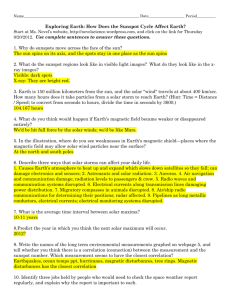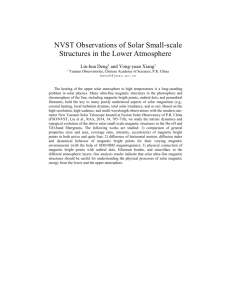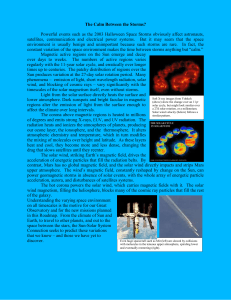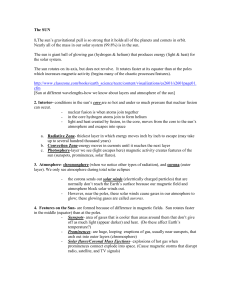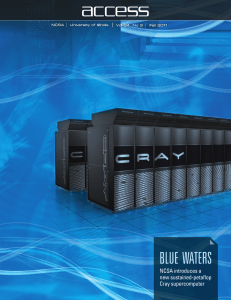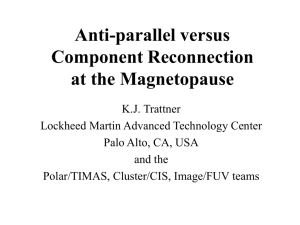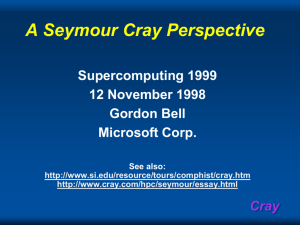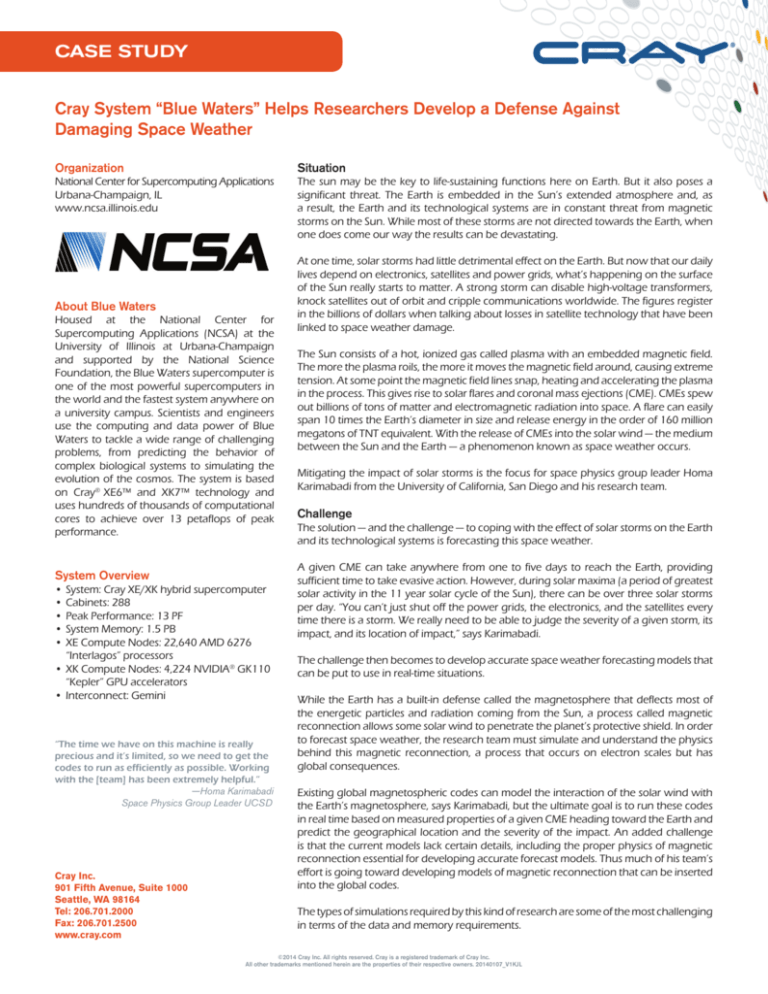
CASE STUDY
Cray System “Blue Waters” Helps Researchers Develop a Defense Against
Damaging Space Weather
Organization
Situation
National Center for Supercomputing Applications
Urbana-Champaign, IL
www.ncsa.illinois.edu
The sun may be the key to life-sustaining functions here on Earth. But it also poses a
significant threat. The Earth is embedded in the Sun’s extended atmosphere and, as
a result, the Earth and its technological systems are in constant threat from magnetic
storms on the Sun. While most of these storms are not directed towards the Earth, when
one does come our way the results can be devastating.
About Blue Waters
Housed at the National Center for
Supercomputing Applications (NCSA) at the
University of Illinois at Urbana-Champaign
and supported by the National Science
Foundation, the Blue Waters supercomputer is
one of the most powerful supercomputers in
the world and the fastest system anywhere on
a university campus. Scientists and engineers
use the computing and data power of Blue
Waters to tackle a wide range of challenging
problems, from predicting the behavior of
complex biological systems to simulating the
evolution of the cosmos. The system is based
on Cray® XE6™ and XK7™ technology and
uses hundreds of thousands of computational
cores to achieve over 13 petaflops of peak
performance.
System Overview
•System: Cray XE/XK hybrid supercomputer
•Cabinets: 288
•Peak Performance: 13 PF
•System Memory: 1.5 PB
•XE Compute Nodes: 22,640 AMD 6276
“Interlagos” processors
•XK Compute Nodes: 4,224 NVIDIA® GK110
“Kepler” GPU accelerators
•Interconnect: Gemini
“The time we have on this machine is really
precious and it’s limited, so we need to get the
codes to run as efficiently as possible. Working
with the [team] has been extremely helpful.”
—Homa Karimabadi
Space Physics Group Leader UCSD
Cray Inc.
901 Fifth Avenue, Suite 1000
Seattle, WA 98164
Tel: 206.701.2000
Fax: 206.701.2500
www.cray.com
At one time, solar storms had little detrimental effect on the Earth. But now that our daily
lives depend on electronics, satellites and power grids, what’s happening on the surface
of the Sun really starts to matter. A strong storm can disable high-voltage transformers,
knock satellites out of orbit and cripple communications worldwide. The figures register
in the billions of dollars when talking about losses in satellite technology that have been
linked to space weather damage.
The Sun consists of a hot, ionized gas called plasma with an embedded magnetic field.
The more the plasma roils, the more it moves the magnetic field around, causing extreme
tension. At some point the magnetic field lines snap, heating and accelerating the plasma
in the process. This gives rise to solar flares and coronal mass ejections (CME). CMEs spew
out billions of tons of matter and electromagnetic radiation into space. A flare can easily
span 10 times the Earth’s diameter in size and release energy in the order of 160 million
megatons of TNT equivalent. With the release of CMEs into the solar wind — the medium
between the Sun and the Earth — a phenomenon known as space weather occurs.
Mitigating the impact of solar storms is the focus for space physics group leader Homa
Karimabadi from the University of California, San Diego and his research team.
Challenge
The solution — and the challenge — to coping with the effect of solar storms on the Earth
and its technological systems is forecasting this space weather.
A given CME can take anywhere from one to five days to reach the Earth, providing
sufficient time to take evasive action. However, during solar maxima (a period of greatest
solar activity in the 11 year solar cycle of the Sun), there can be over three solar storms
per day. “You can’t just shut off the power grids, the electronics, and the satellites every
time there is a storm. We really need to be able to judge the severity of a given storm, its
impact, and its location of impact,” says Karimabadi.
The challenge then becomes to develop accurate space weather forecasting models that
can be put to use in real-time situations.
While the Earth has a built-in defense called the magnetosphere that deflects most of
the energetic particles and radiation coming from the Sun, a process called magnetic
reconnection allows some solar wind to penetrate the planet’s protective shield. In order
to forecast space weather, the research team must simulate and understand the physics
behind this magnetic reconnection, a process that occurs on electron scales but has
global consequences.
Existing global magnetospheric codes can model the interaction of the solar wind with
the Earth’s magnetosphere, says Karimabadi, but the ultimate goal is to run these codes
in real time based on measured properties of a given CME heading toward the Earth and
predict the geographical location and the severity of the impact. An added challenge
is that the current models lack certain details, including the proper physics of magnetic
reconnection essential for developing accurate forecast models. Thus much of his team’s
effort is going toward developing models of magnetic reconnection that can be inserted
into the global codes.
The types of simulations required by this kind of research are some of the most challenging
in terms of the data and memory requirements.
©2014 Cray Inc. All rights reserved. Cray is a registered trademark of Cray Inc.
All other trademarks mentioned herein are the properties of their respective owners. 20140107_V1KJL
CASE STUDY
Page #2
Solution
A petascale computing allocation received through the National Science Foundation enabled Karimabadi and his research team to prepare
their codes for extreme-scale supercomputers and tap into the computing and data power of Blue Waters. “We wanted to know if we
changed the parameters, such as system size, would the physics change,” Karimabadi says, “and if it did, could we develop scaling laws to
extrapolate the results to real systems in nature.”
The Cray® XE™/XK™ hybrid “Blue Waters” supercomputer made it possible for the team to push their simulations to the largest size possible on
any supercomputer today. But even more, technical collaborations between the NCSA Blue Waters team, Cray, the San Diego Supercomputer
Center and Los Alamos National Laboratory helped the team optimize their codes. One collaboration resulted in increased performance of
their H3D code — a global code that treats electrons as fluids and ions as kinetic particles. Another resulted in improvements to VPIC — the
kinetic code that models individual particles for the inclusion of electron physics — as a part of the sustained petascale performance (SPP)
optimization effort.
Prior to petascale computing, almost all of the global simulations were based on fluid
models. But Blue Waters has given the team new options. With hundreds of thousands of
computational cores, the system is enabling global simulations that include important ion
kinetic physics using H3D code and local simulations that resolve both ion and electron
kinetic physics using the code VPIC.
The performance gains took some work, though. NCSA research programmer Kalyana
Chadalavada implemented the use of more fused multiply-add (FMA) instructions, while
Jim Kohn of Cray eliminated some redundant stores to temporary variables and reordered
some independent Streaming SIMD Extensions (SSE) instructions for better resource
utilization on the chip. Chadalavada says they were able to achieve an improvement of
12–18 percent by using more FMA instructions, as well as another 5 percent improvement
by eliminating some redundancy and rearranging some parts of the code.
“At scale, a significant portion of the run time is spent transferring particle data between
processors. Changing the relevant communication routines by, for example, overlapping
more communication with computation, could reduce the total simulation time
considerably,” Chadalavada says.
The holy grail of space plasmas and space physics would be to figure out how to model
magnetic reconnection—which we now know depends heavily on and is strongly
affected by electron kinetic effects—in a global code where it is not possible to resolve
electron kinetic effects. Capturing the essence of magnetic reconnection in this way is the
key to precise prediction of space weather and Karimabadi’s team is starting to see that
breakthrough form in their future.
In fact, their work with NCSA and Blue Waters has already produced a major revolution
for their discipline says Karimabadi. In a fluid model, there aren’t any particles so there
aren’t things bouncing off or deflecting. There is nothing to generate waves, so a lot of
important information is lost.
MODELING SPACE WEATHER: Magnetic field lines as visualized
by the line integral convolution technique. The color is based on the
magnitude of the magnetic field. The “closed” lines along the magnetopause current sheets are 3-D flux ropes.
“There have long been speculations about how the electron and ion kinetic effects affect
details of the reconnection process and its global consequences. Many of the ideas can
now be tested and new ideas and questions formulated to make further progress,”
Karimabadi says. “Now that we have been able to go beyond fluid models, which ignore
details on small scales, we have uncovered new and unexpected effects and are
finding ample evidence that physical processes occurring on small scales have global
consequences.”
Overall, the team has discovered new regimes of reconnection and scaling relations with system size and parameters. “It’s almost like you
have always had really poor eyesight and someone gave you glasses for the first time. You start to see a lot of details that were completely
absent in the previous simulations,” says Karimabadi.
For more information on NCSA’s space weather work, visit www.ncsa.illinois.edu/news/story/so_much_detail.
Content courtesy of National Center for Supercomputing Applications at the University of Illinois Urbana-Champaign




